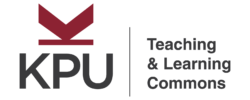What is it?
Multiple-choice tests using CBM (confidence-based marking) require two inputs from students for each question:
- Their answer choice
- Their level of confidence in their answer choice
A student earns maximum points for a correct answer they are fully confident in. They are penalized for wrong answers that they are strongly confident in. Acknowledged ignorance (low confidence in a wrong answer) is not penalized. Awareness of the limits of one’s knowledge is part of developing a student’s ability to analyze and think critically—a Future Skill for KPU students.
| Low Confidence | Mid Confidence | High Confidence | |
|---|---|---|---|
| Right answer | 1 | 2 | 3 |
| Wrong answer | 0 | ‒2 | ‒6 |
Gardner-Medwin derives an overall score for a student by combining the student’s accuracy score with a confidence-based bonus based on how well they discriminated between right and wrong answers. To simplify the calculations, all questions are equally weighted on the test.
CBM can be used as part of summative assessment, but it is probably more powerful as a formative assessment. In fact, Gardner-Medwin hosts a self-test site where students quiz themselves on various topics ranging from English idioms to medicine. Students get immediate feedback on their responses, and can develop a sense of their strengths, weaknesses, and misconceptions.
What are the benefits?
A common criticism of multiple-choice tests is that they cannot distinguish between correct answers that come from knowledge and correct answers that come from guessing. Confidence-based marking (or certainty-based marking, CBM) can reward students for thoughtful, correct answers. It helps students see if they are over-confident or under-confident in their understanding of the material. It can also help instructors see trends in what topics students feel unsure about. CBM was originally developed by physiology professor Tony Gardner-Medwin at University College London.
What are the challenges?
Students may be unfamiliar with the idea, and reluctant to assign a confidence level to their answers.
The marking load for the instructor is increased, since each question must be evaluated not only for the correct answer, but also for the confidence level.
Who’s using this?
Pending… if you’ve used this technique and you’re willing to share thoughts about your and your students’ experience, send me an email!
References
Yuen-Reed, G., & Reed, K. B. (2015). Engineering student self-assessment through confidence-based scoring. Advances in Engineering Education, 4(4). https://eric.ed.gov/?id=EJ1077841

